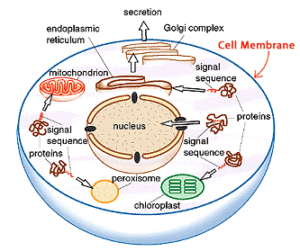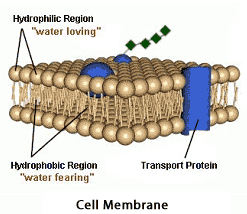Our body is comprised of over a hundred trillion individual cells. Cells are the building blocks of life, but can be also thought of as microscopic human beings, with a miniature brain (DNA) and an energy source (the energy-producing mitochondria). They are able to communicate with one another and can produce proteins and hormones. One can think of cells as small factories working continuously.
Cells are enclosed by a very thin semi-permeable membrane which has many small pores (holes).

Through the membrane, many nutrients important for cell function can enter, while the waste products of cell metabolism can be excreted. The cell membrane is not only permeable to nutrients necessary for cell function, but also to damaging toxic materials (such as mercury and lead).
Cells are engaged in a continuous process of supply and demand for nutrients. Similar to us, cells need “food” in order to survive and function properly. Some nutrients are made in the body, while others are essential for cell function, and must be supplied by external sources because the body cannot synthesize them.
In order for the cell to function well, it is essential not only that the nutrients reach the cell, but also that waste products are removed.
Cell Balance
In order for cells to function appropriately and survive, they require a balanced supply of nutrients (such as water, vitamins, minerals, hormones), a clean environment, proper acid-base balance, and the ability to remove the waste products of cell metabolism.
Transportation
Transportation is the process by which nutrients required for cell function are able to reach the cell, while waste products of cell metabolism are removed.
The process of transportation involves:
- The absorption of nutrients and excretion of waste products
The main locations of nutrient absorption and excretion of waste products are the skin, gastrointestinal tract (from the mouth to the rectum), and the respiratory system. Poor nutrient absorption and inadequate excretion of waste products (detoxification) may cause imbalance in cell function and cell damage. - An open and well functioning circulatory system
The circulatory system includes the big arteries and veins (such as the aorta, vena cava, brain, heart, kidney, and bowel arteries and veins), and the small blood vessels, such as the arterioles, metarterioles, venules, capillaries, and lymphatics. The great arteries have thick walls. The arteries become smaller, and their walls thinner, as they branch outward toward the periphery (similarly to the branches of a tree). Ultimately, they divide into microscopically small blood vessels, the arterioles (the mean diameter of the lumen of the arterioles is about 30 microns), and then into capillaries.
The capillaries are the preeminent site of “food” (nutrients, hormones, water) exchange between the blood and tissue cells. The number of capillaries varies in different tissues. For example, muscles have 300-600 capillaries per square millimeter. Only a fraction of the capillaries in skeletal muscles are open at rest- the rest are in a state of collapse. During exercise, the entire capillary bed may open (Sherwood, L. Human Physiology: From Cells to Systems, Wadsworth Publishing Company, 2000).
Blood vessels bring nutrients from their site of absorption or production to cells throughout the body. Poor circulation disturbs the supply of nutrients (such as water, oxygen, and minerals) to cells, in addition to limiting the efficient removal of the waste products of cell metabolism. There are many reasons that can lead to impaired circulation through blood vessels, including:
- atherosclerotic plaques
- blood clots
- unstable plaques
inflammation - glycation
- vasoconstriction of blood vessels
Poor transportation of nutrients or hormones is similar to a letter that is mailed but fails to arrive due to a strike or bad weather. The main blood vessels (“rivers”) may be open, but small blood vessels (“streams”) that deliver food to the cells may have collapsed or have become blocked by plaques or small fibrin clot deposits. Eventually, larger blood vessels may also become clogged. It is only with the large and small vessels remaining open and free-flowing that all of the cells’ nutritional requirements can be met appropriately, while waste products are removed.
3. Normal cell membrane function
The cell membrane is a thin  elastic structure 7.5-10 nanometers thick. It is essentially a sheet of lipid (fat) material, containing primarily phospholipids and cholesterol, with interspersed proteins (Ohvo-Rekila H, Ramstedt B, Leppimaki P, Slotte JP. Cholesterol interactions with phospholipids in membranes. Prog Lipid Res 2002 Jan; 41(1):66-97). Normal cell membrane function is essential for passive nutrient diffusion in and out of the cell, as well as for active (i.e. requiring energy) transport across the membrane. Changes in cell membrane structure affect nutrient transfer. For example, a change in lipid concentration may affect membrane fluidity, making it more or less fluid.
elastic structure 7.5-10 nanometers thick. It is essentially a sheet of lipid (fat) material, containing primarily phospholipids and cholesterol, with interspersed proteins (Ohvo-Rekila H, Ramstedt B, Leppimaki P, Slotte JP. Cholesterol interactions with phospholipids in membranes. Prog Lipid Res 2002 Jan; 41(1):66-97). Normal cell membrane function is essential for passive nutrient diffusion in and out of the cell, as well as for active (i.e. requiring energy) transport across the membrane. Changes in cell membrane structure affect nutrient transfer. For example, a change in lipid concentration may affect membrane fluidity, making it more or less fluid.
- Why Healthy Aging Medicine?
- What is Healthy Aging Medicine?*
- Beating Heart Disease – Public Enemy Number One
- HGH, the Master Hormone of Youth*
- The Pacemakers of Youth*
- My Best Friend, My Worst Enemy
- Joining a Longevity Program: What to look for
- Fighting the Aging Process: Quick Fixes and Misconceptions
- Other Theories of Aging
- Signs and Symptoms of Aging
- Life Expectancy
- Demographics of Aging
Our Unique Approach
The Cell First® Theory of Aging serves as the basis for many of our health and longevity programs and services. It was developed by Dr. S. Bergman, medical director of Longevity Healthy Aging® (LHA®), and board certified in Anti-Aging Medicine. See our programs and services page.–>- An appropriate balance of essential fatty acids in phospholipids is very important for normal cell function and general health. Test and balance your essential fatty acids in phospholipids.
- Inflammation and glycation are important causes of cell damage and aging.
